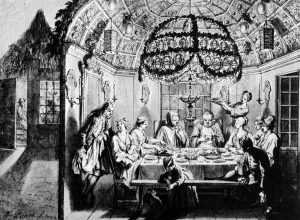
Bernard Picart: Dinner in the Sukkah, Amsterdam 1722 (Public Domain)
You shall dwell in booths for seven days; all Israelites shall dwell in booths,” tells Lev. 23:42. In compliance with this commandment, Jews around the world erect outdoor huts in which the autumn holiday of Sukkot is celebrated. Once observed as a festival of thanksgiving for the bounties of nature, the Feast of the Tabernacles is also linked with the forty-year period during which the children of Israel were wandering in the desert, living in temporary shelters. Thus, the booth, or sukkah, itself must be a temporary abode.
“Be a mentsh and you can sit in the sukkah,” says an old Yiddish adage. It reminds the young that there is an adult ideal they should try to reach; in general, the sukkah teaches us not to put our trust in the size, the strength or the improvements of our home, but in God.
The medieval Jewish thinker Maimonides admonished that anyone who sits comfortably with his family within his own walls and does not share with the poor is performing a mitzvah not for joy but for the stomach. This applies to meals in the sukkah as well, and it is customary to extend a personal invitation to the needy.
The huts today come in all sizes and materials and there are thriving prefab sukkah businesses in many larger Jewish communities. Throughout the ages, there has been a tendency to make this temporary home as comfortable and welcoming as possible, accommodating family and friends who are eating, reading and even sleeping there.
However, the famous master of Zanz, Rabbi Chayim Halberstam (1793–1876), preferred a sparsely decorated sukkah to ornate dwellings. While many of the Hassidic rebbes of Galicia would spend enormous amounts of money for such a holiday extravaganza, he explained: “There is no finer way of decorating the sukkah than to see to it that the poor are not hungry.”
Another custom is to open the hut symbolically for seven ushpizin (Aramaic for “guests”) to take up residence in the booth. The formula originated among the Kabbalists in the 16th century and is based on a verse in the earlier Book of Zohar which says: “When a man sits in the shadow of faith (sukkah) the Divine Presence spreads Her wings on him from above and Abraham and five other righteous ones of God (and David with them) make their abode with him. A man should rejoice each day of the festival with these guests.” Each one of the seven supernal guests in turn is seen as leading the others into the sukkah. They join us as we discuss their teachings and honor their contributions to our people. “The past, in this way, becomes the present,” explained Rabbi Louis Jacobs (1920–2006).
Especially in Progressive Judaism, it has become popular to single out female characters alongside with the seven exalted men of Israel, first of all the matriarchs and other important women of Israel: Sarah, Rachel, Rebecca, Leah, Miriam, Abigail, and Esther. Of course, it seems appropriate to grow the invite list to reflect the contemporary Jewish landscape, pairing biblical leaders with our role models of today. It is said that the ushpizin would refuse to enter a sukkah where the poor are not welcome, and sometimes provisions or donations are sent to the needy along with a note saying, “This is the share of the ushpizin.” The inspiration for this hospitality to guests goes back to the first patriarch, Abraham, who generously welcomed three wayfarers to his tent who then proved to be angels.■
